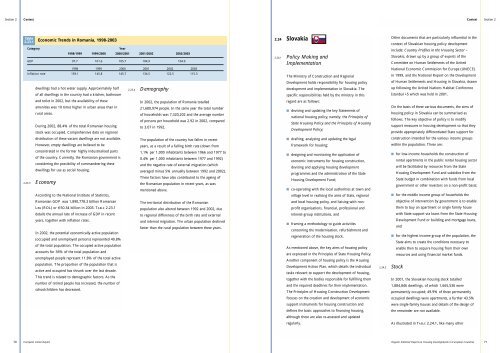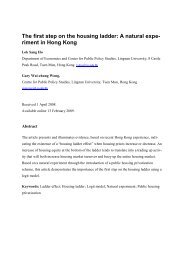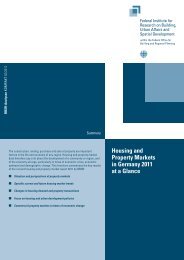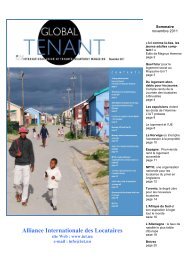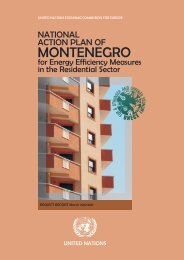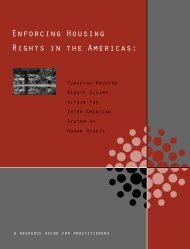housing developments in european countries - Department of ...
housing developments in european countries - Department of ...
housing developments in european countries - Department of ...
You also want an ePaper? Increase the reach of your titles
YUMPU automatically turns print PDFs into web optimized ePapers that Google loves.
Section 2<br />
Context<br />
Context Section 2<br />
Table<br />
2.23.1<br />
Category<br />
Economic Trends <strong>in</strong> Romania, 1998-2003<br />
dwell<strong>in</strong>gs had a hot water supply. Approximately half<br />
<strong>of</strong> all dwell<strong>in</strong>gs <strong>in</strong> the country had a kitchen, bathroom<br />
and toilet <strong>in</strong> 2002, but the availability <strong>of</strong> these<br />
amenities was 10 times higher <strong>in</strong> urban areas than <strong>in</strong><br />
rural areas.<br />
Dur<strong>in</strong>g 2002, 88.4% <strong>of</strong> the total Romanian <strong>hous<strong>in</strong>g</strong><br />
stock was occupied. Comprehensive data on regional<br />
distribution <strong>of</strong> these vacant dwell<strong>in</strong>gs are not available.<br />
However, empty dwell<strong>in</strong>gs are believed to be<br />
concentrated <strong>in</strong> the former highly <strong>in</strong>dustrialised parts<br />
<strong>of</strong> the country. Currently, the Romanian government is<br />
consider<strong>in</strong>g the possibility <strong>of</strong> commandeer<strong>in</strong>g these<br />
dwell<strong>in</strong>gs for use as social <strong>hous<strong>in</strong>g</strong>.<br />
2.23.3 Economy<br />
Year<br />
1998/1999 1999/2000 2000/2001 2001/2002 2002/2003<br />
GDP 97.7 101.6 105.7 104.9 104.9<br />
1998 1999 2000 2001 2002 2003<br />
Inflation rate 159.1 145.8 145.7 134.5 122.5 115.3<br />
Accord<strong>in</strong>g to the National Institute <strong>of</strong> Statistics,<br />
Romanian GDP was 1,890,778.3 billion Romanian<br />
Leu (ROL) or €50.34 billion <strong>in</strong> 2003. TABLE 2.23.1<br />
details the annual rate <strong>of</strong> <strong>in</strong>crease <strong>of</strong> GDP <strong>in</strong> recent<br />
years, together with <strong>in</strong>flation rates.<br />
In 2002, the potential economically active population<br />
(occupied and unemployed persons) represented 40.8%<br />
<strong>of</strong> the total population. The occupied active population<br />
accounts for 36% <strong>of</strong> the total population and<br />
unemployed people represent 11.8% <strong>of</strong> the total active<br />
population. The proportion <strong>of</strong> the population that is<br />
active and occupied has shrunk over the last decade.<br />
This trend is related to demographic factors. As the<br />
number <strong>of</strong> retired people has <strong>in</strong>creased, the number <strong>of</strong><br />
schoolchildren has decreased.<br />
2.23.4 Demography<br />
In 2002, the population <strong>of</strong> Romania totalled<br />
21,680,974 people. In the same year the total number<br />
<strong>of</strong> households was 7,320,202 and the average number<br />
<strong>of</strong> persons per household was 2.92 <strong>in</strong> 2002, compared<br />
to 3.07 <strong>in</strong> 1992.<br />
The population <strong>of</strong> the country has fallen <strong>in</strong> recent<br />
years, as a result <strong>of</strong> a fall<strong>in</strong>g birth rate (down from<br />
1.1% per 1,000 <strong>in</strong>habitants between 1966 and 1977 to<br />
0.4% per 1,000 <strong>in</strong>habitants between 1977 and 1992)<br />
and the negative rate <strong>of</strong> external migration (which<br />
averaged m<strong>in</strong>us 5% annually between 1992 and 2002).<br />
These factors have also contributed to the age<strong>in</strong>g <strong>of</strong><br />
the Romanian population <strong>in</strong> recent years, as was<br />
mentioned above.<br />
The territorial distribution <strong>of</strong> the Romanian<br />
population also altered between 1992 and 2002, due<br />
to regional differences <strong>of</strong> the birth rate and external<br />
and <strong>in</strong>ternal migration. The urban population decl<strong>in</strong>ed<br />
faster than the rural population between these years.<br />
2.24 Slovakia<br />
2.24.1 Policy Mak<strong>in</strong>g and<br />
Implementation<br />
The M<strong>in</strong>istry <strong>of</strong> Construction and Regional<br />
Development holds responsibility for <strong>hous<strong>in</strong>g</strong> policy<br />
development and implementation <strong>in</strong> Slovakia. The<br />
specific responsibilities held by the m<strong>in</strong>istry <strong>in</strong> this<br />
regard are as follows:<br />
■ devis<strong>in</strong>g and updat<strong>in</strong>g the key Statements <strong>of</strong><br />
national <strong>hous<strong>in</strong>g</strong> policy, namely: the Pr<strong>in</strong>ciples <strong>of</strong><br />
State Hous<strong>in</strong>g Policy and the Pr<strong>in</strong>ciples <strong>of</strong> Hous<strong>in</strong>g<br />
Development Policy;<br />
■ draft<strong>in</strong>g, analys<strong>in</strong>g and updat<strong>in</strong>g the legal<br />
framework for <strong>hous<strong>in</strong>g</strong>;<br />
■ design<strong>in</strong>g and monitor<strong>in</strong>g the application <strong>of</strong><br />
economic <strong>in</strong>struments for <strong>hous<strong>in</strong>g</strong> construction,<br />
devis<strong>in</strong>g and apply<strong>in</strong>g <strong>hous<strong>in</strong>g</strong> development<br />
programmes and the adm<strong>in</strong>istration <strong>of</strong> the State<br />
Hous<strong>in</strong>g Development Fund;<br />
■ co-operat<strong>in</strong>g with the local authorities at town and<br />
village level <strong>in</strong> realis<strong>in</strong>g the aims <strong>of</strong> State, regional<br />
and local <strong>hous<strong>in</strong>g</strong> policy, and liais<strong>in</strong>g with nonpr<strong>of</strong>it<br />
organisations, f<strong>in</strong>ancial, pr<strong>of</strong>essional and<br />
<strong>in</strong>terest-group <strong>in</strong>stitutions, and<br />
■ fram<strong>in</strong>g a methodology to guide activities<br />
concern<strong>in</strong>g the modernisation, refurbishment and<br />
regeneration <strong>of</strong> the <strong>hous<strong>in</strong>g</strong> stock.<br />
As mentioned above, the key aims <strong>of</strong> <strong>hous<strong>in</strong>g</strong> policy<br />
are expressed <strong>in</strong> the Pr<strong>in</strong>ciples <strong>of</strong> State Hous<strong>in</strong>g Policy.<br />
Another component <strong>of</strong> <strong>hous<strong>in</strong>g</strong> policy is the Hous<strong>in</strong>g<br />
Development Action Plan, which details the <strong>in</strong>dividual<br />
tasks relevant to support the development <strong>of</strong> <strong>hous<strong>in</strong>g</strong>,<br />
together with the bodies responsible for fulfill<strong>in</strong>g them<br />
and the required deadl<strong>in</strong>es for their implementation.<br />
The Pr<strong>in</strong>ciples <strong>of</strong> Hous<strong>in</strong>g Construction Development<br />
focuses on the creation and development <strong>of</strong> economic<br />
support <strong>in</strong>struments for <strong>hous<strong>in</strong>g</strong> construction and<br />
def<strong>in</strong>es the basic approaches to f<strong>in</strong>anc<strong>in</strong>g <strong>hous<strong>in</strong>g</strong>,<br />
although these are also re-assessed and updated<br />
regularly.<br />
Other documents that are particularly <strong>in</strong>fluential <strong>in</strong> the<br />
context <strong>of</strong> Slovakian <strong>hous<strong>in</strong>g</strong> policy development<br />
<strong>in</strong>clude: Country Pr<strong>of</strong>iles <strong>in</strong> the Hous<strong>in</strong>g Sector –<br />
Slovakia, drawn up by a group <strong>of</strong> experts <strong>of</strong> the<br />
Committee on Human Settlements <strong>of</strong> the United<br />
National Economic Commission for Europe (UNECE)<br />
<strong>in</strong> 1999, and the National Report on the Development<br />
<strong>of</strong> Human Settlements and Hous<strong>in</strong>g <strong>in</strong> Slovakia, drawn<br />
up follow<strong>in</strong>g the United Nations Habitat Conference<br />
Istanbul +5 which was held <strong>in</strong> 2001.<br />
On the basis <strong>of</strong> these various documents, the aims <strong>of</strong><br />
<strong>hous<strong>in</strong>g</strong> policy <strong>in</strong> Slovakia can be summarised as<br />
follows. The key objective <strong>of</strong> policy is to modify<br />
support measures <strong>in</strong> <strong>hous<strong>in</strong>g</strong> development so that they<br />
provide appropriately differentiated State support for<br />
construction <strong>in</strong>tended for the various <strong>in</strong>come groups<br />
with<strong>in</strong> the population. These are:<br />
■ for low-<strong>in</strong>come households the construction <strong>of</strong><br />
rental apartments <strong>in</strong> the public rental <strong>hous<strong>in</strong>g</strong> sector<br />
will be facilitated by resources from the State<br />
Hous<strong>in</strong>g Development Fund and subsidies from the<br />
State budget <strong>in</strong> comb<strong>in</strong>ation with funds from local<br />
government or other <strong>in</strong>vestors on a non-pr<strong>of</strong>it basis;<br />
■ for the middle <strong>in</strong>come group <strong>of</strong> households the<br />
objective <strong>of</strong> <strong>in</strong>tervention by government is to enable<br />
them to buy an apartment or s<strong>in</strong>gle family house<br />
with State support via loans from the State Hous<strong>in</strong>g<br />
Development Fund or build<strong>in</strong>g and mortgage loans,<br />
and<br />
■ for the highest <strong>in</strong>come group <strong>of</strong> the population, the<br />
State aims to create the conditions necessary to<br />
enable then to acquire <strong>hous<strong>in</strong>g</strong> from their own<br />
resources and us<strong>in</strong>g f<strong>in</strong>ancial market funds.<br />
2.24.2 Stock<br />
In 2001, the Slovakian <strong>hous<strong>in</strong>g</strong> stock totalled<br />
1,884,846 dwell<strong>in</strong>gs, <strong>of</strong> which 1,665,536 were<br />
permanently occupied; 49.9% <strong>of</strong> these permanently<br />
occupied dwell<strong>in</strong>gs were apartments, a further 43.5%<br />
were s<strong>in</strong>gle-family houses and details <strong>of</strong> the design <strong>of</strong><br />
the rema<strong>in</strong>der are not available.<br />
As illustrated <strong>in</strong> TABLE 2.24.1, like many other<br />
70 European Union Report<br />
Regular National Report on Hous<strong>in</strong>g Developments <strong>in</strong> European Countries<br />
71


